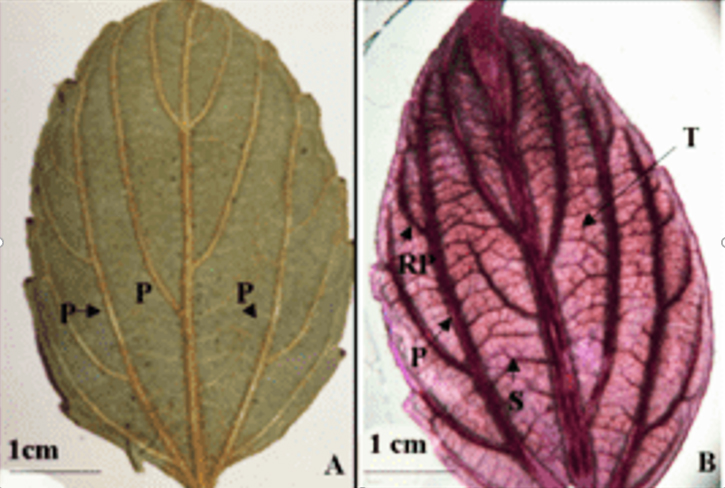Contribution to the taxonomy of Mexican species of the genus Colubrina (Rhamnaceae) based on leaf architecture and epidermal surface characteristics
Nuevas Contribuciones a la Taxonomía de las especies mexicanas del género Colubrina (Rhamnaceae) basadas en la Arquitectura foliar y las superficies epidérmicas de las hojas: Colubrina
DOI:
https://doi.org/10.18387/polibotanica.59.2Keywords:
Subgenus Serrataria, Subgenus Colubrina, venation types, trichomes, glands, plant diversityAbstract
This study describes the leaf architecture and epidermal surfaces of nine Colubrina species distributed across Mexico, encompassing two subgenera and three sections. The species are categorized as follows: Subgenus Colubrina Section Colubrina with C. arborescens; Section Cowaiana with C. elliptica, C. heteroneura, C. johnstonii, and C. viridis; Section Barcena with C. ehrenbergii and C. triflora; and Subgenus Serrataria with C. californica and C. celtidifolia. Taxa differentiation was achieved by examining venation types (craspedodromous, brochidodromous, and imperfect basal acrodromous), branching patterns of the first pair of lower secondary veins, the number of secondary veins, trichome types (with or without a radial base, or absent), the presence or absence of glands on the leaf blade, straight or wavy epidermal walls, the presence or absence of free veins in the third and fourth category veins, and stomatal types. A dichotomous key and a clustering analysis were performed using the UPGMA method and the Jaccard similarity index, and a corresponding dendrogram is provided. The results from seven previously published species of Subgenus Serrataria (C. stricta, C. celtidifolia, C. greggii, C. lanulosa, C. macrocarpa, C. texensis, and C. yucatanensis) were considered in the discussions and conclusions to infer the similarities and differences among the 16 Colubrina taxa found in Mexico. The study found that Serrataria species lack glands in their marginal teeth, a key characteristic in the literature, and that the tooth protuberances are due to feeding through a secondary or tertiary vein. This suggests the need for a redescription or reassignment of this subgenus. The dendrogram separates the taxa into three main groups: one comprising Sections Cowaiana and Barcena, a second grouping that includes C. arborescens (from Section Colubrina) along with the nine Serrataria species. The inclusion of C. arborescens in this group is likely due to significant differences observed in specimens from southern Mexico compared to Caribbean taxa, potentially indicating it as a distinct taxon. The third grouping further separates the Serrataria species based on their venation patterns.
References
Ash, , A., Ellis, , B., Hickey, L. J., Johnson, K. R., Wilf, P., & Wing, S. L. (199). Manual of Leaf Architecture - morphological description and categorization ofdicotyledonous and net-veined monocotyledonous angiosperms by Leaf Architecture Working Group. 65 p. Institución Smithsonian.
https://www.researchgate.net/publication/270216765_Manual_of_Leaf_Architecture__Morphological_description_and_categorization_of_dicotyledonous_and_netveined_monocotyledonous_angiosperms
Azcárraga, R., M., Bonfil C., A., Jácquez, R., M., y Sandoval, Z., E. (2010). Atlas de Anatomía Vegetal. (F. d. Cuautitlán, Ed.) Ciudad de México, México: U.N.A.M. Dirección General de Publicaciones y Fomento Editorial.
Colares, M. N. y Arambarri, A. M. (2008). Ziziphus mistol (Rhamnaceae): Morfoanatomía y Arquitectura Foliar. Lat. Am. J. Pharm., 27(4), 568-577.
Cortés, F. (1982). Cuadernos de Histología Vegetal. Ed. Marban. Madrid, España.
Dilcher, D. L. (1974). Approaches to the Identification of Angiosperm Leaf Remains. Bot. Rev., 40(1), 1-157.
Fernández N., R. (1993). La familia Rhamnaceae en México. Tesis Doctoral. Escuela Nacional de Ciencias Biológicas. Instituto Politécnico Nacional. Fernández N., R. (1996). Rhamnaceae. Flora del Bajío y de Regiones adyacentes (Fascículo 43), 1-69.
Fernández N., R. (2010). Nombres comunes, etnobotánica y distribución geográfica del género Colubrina (Rhamnaceae) en México. Revista Científica UDO Agrícola, 10(1), 7-22.
Fernández-Nava, R.; M.L. Arreguín-Sánchez y C.Y. Jorge Cruz. 2024. Características taxonómicas de las especies de Colubrina (Rhamnaceae) en México, basadas en la arquitectura y superficies epidérmicas. Polibotánica 57: 1-22. DOI:10.18387/polibotanica.57.1
Gola, G., Negri, G., y Cappelletti, C. (1965). Tratado de Botánica. Segunda edición. Ed. Labor, S. A. México.
Hernández-Peñaloza., K., Fernández-Nava., R., y Arreguín-Sánchez., M. L. (2021). Arquitectura foliar y anatomía epidérmica de las especies mexicanas del género Gouania (Rhamnaceae). Polibotánica (52), 151-176.
Hickey, L. J. (1973). Classification of the Architecture of Dicotyledonous Leaves. Amer. J. Bot., 60(1), 17-33.
Hickey, L. J. (1974). Clasificación de la arquitectura de las hojas de dicotiledoneas. Bol. Soc. Argent. Bot., 16(1-2), 1-26.
Hickey, L. J., & Wolfe, J. A. (1975). The Bases of Angiosperms Phylogeny: Vegetative Morphology. Ann. Mo. Bot. Gard. 62, 538-589.
Johnston, M. (1963). Novelties in Colubrina including Cormonema and Hybosperma. Wrightia 3, 91-96.
Johnston, M. C. (1969). Colubrina stricta Engelmann ex M. C. Johnston (Rhamnaceae), new species from Texas, Nuevo Leon and Coahuila. The Southwestern Naturalist, 14(2), 257. doi:https://doi.org/10.2307/3668886
Johnston, M. (1971). Revision of Colubrina (Rhamnaceae). Brittonia 23, 2-53.
Martínez, M. (1979). Las Ramnáceas. En: Flora del Estado de México. Biblioteca Enciclopédica del Estado de México. Biblioteca Enciclopédica del Estado de México 1, 282-286. 21 Núm. 57: 1-22. ISSN electrónico: 2395-9525.
Meyer, R. y Meola, S. (1978). Morphological characteristics of leaves and stems of selected Texas Woody plants. U.S. Departament of Agriculture Technical Bulletin 1564, 1-200.
Nesom, G. (2013). Taxonomic notes Colubrina (Rhamnaceae). Phytoneuron 4, 1-21. Schirarend, C. (1991). The Systematic Wood anatomy of the Rhamnaceae Juss. (Rhamnales). I. Tribu Zizipheae. Iawa Bull. n.s., 12(4), 359-388.
Programa estadístico Past 4.3. https://past4.software.informer.com/4.3/
Shisode, S. B. y Patil, D. A. (2011). Petiolar anatomy in some Rhamnaceae. Current Botany, 2(9), 22-25.
Standley, P. C. (1923). Rhamnaceae. Trees and Shrubs of Mexico. Contr. U.S. Nat. Herb. 23(6), 710-727.
Wendt, T. (1983). Plantae Uxpanapae l. Colubrina johnstonii sp. nov. (Rhamnaceae). Bol. Soc. Bot. Méx. 44:81-90.
Wiggins, I. L. (1964). Vegetation and Flora of the Sonoran Desert. Stanford University Press. pp. 856-869.
Wiggins, I. L. (1980). Flora of Baja California. Stanford University Press. Calif. pp 780-787.

Downloads
Published
License

Polibotánica by Departamento de Botánica de la Escuela Nacional de Ciencias Biológicas del Instituto Politécnico Nacional se distribuye bajo una Licencia Creative Commons Atribución-NoComercial-CompartirIgual 4.0 Internacional.



















